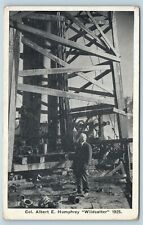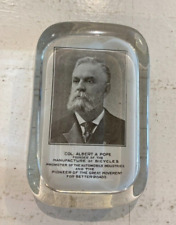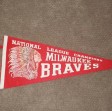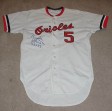When you click on links to various merchants on this site and make a purchase, this can result in this site earning a commission. Affiliate programs and affiliations include, but are not limited to, the eBay Partner Network.
THE INSCRIPTION READS
PRESENTED TO ALBERT G BRACKETT NINTH ILLINOIS CAVALRY
BY THE OFFICERS OF HIS REGIMENT AT CAMP DOUGLAS
CHICAGO ILLINOIS OCT 26TH 1861
THE SWORD SHOWS SIGN OF WARE BUT IS STRAIGHT
PATTERN ON SWORD WORN (SEE PHOTOS)
SCABBARD SHOWS SIGN OF OXIDATION BUT WILL CLEAN UP NICELY.
I AM NOT FAMILIAR WITH THE MAKERS MARK ON THE TOP EDGE OF THE SWORD (SEE PHOTOS.)
I HAVE LISTED SOME INFORMATION ABOUT COL GALLATIN BRACKETT BELOW
Albert Gallatin Brackett of New York
Appointed from Indiana, Second Lieutenant, 4th Indiana Volunteer Infantry, 1 June 1847
First Lieutenant, 18 June 1847
Honorably mustered our, 16 July 1848
Captain, 2nd U.S. Cavalry, 3 March 1855
5th U. S. Cavalry, 3 August 1861
Colonel, 9th Illinois Volunteer Cavalry, 26 October 1861
Honorably mustered out of the Volunteer Service, 26 October 1864
Major, 1st U. S. Cavalry, 17 July 1862
Lieutenant Colonel, Calvary, 9 June 1868
Colonel, 3rd U. S. Cavalry, 20 March 1879
Breveted Major, 28 June 1862, for gallant and meritorious services in the campaign in Arkansas
Breveted Lieuenant Colonel, 1 September 1864, for gallant and meritorious services in the Atlanta Campaign
Breveted Colonel, 13 March 1865 for gallant and meritorious services during the war
Retired 18 February 1891
Died 25 June 1896
Albert Gallatin Brackett, soldier, born in Cherry Valley, Otsego County, New York, 14 February, 1829. He removed to Indiana in 1846, and, during the war with Mexico, was First Lieutenant in the 4th Indiana volunteers, attached to Lane\'s brigade, being present at Huamantla, Puebla, and Atlixco. On 16 July, 1848, he was honorably discharged.
On 3 March, 1855, he became captain in the 2nd United States Cavalry, and, after raising a company in Indiana and Illinois, served on the Texas frontier, distinguishing himself in actions against the Comanche Indians. He was the first United States officer that crossed into Mexico in pursuit of hostile Indians.
When General Twiggs surrendered to the confederates in 1861, Captain Brackett escaped. He commanded the cavalry at Blackburn\'s Ford and the first battle of Bull Run, and in August, 1861, became Colonel of the 9th Illinois cavalry, serving with credit through the Arkansas campaign, and being severely wounded at Stewart\'s Plantation, where he saved a valuable train from falling into the hands of the Confederates.
On 28 June, 1862, he was brevetted Major in the regular army for services in the Arkansas campaign, and on 17 July received his full commission as Major in the 1st U. S. Cavalry. In 1863 he was Chief of Cavalry in the department of the Missouri, and in 1864 Assistant Inspector General of Cavalry, in the Department of the Cumberland.
He was engaged in the battles around Atlanta, was brevetted Lieutenant Colonel on 1 September, 1864, for his services there, and at the close of the war was brevetted Colonel.
After that time he served principally against hostile Indians in Nevada, Wyoming, and Arizona. He received his full commission as Lieutenant Colonel, 2nd U. S. Cavalry, on 9 June, 1868, and on 20 March, 1879, when commanding the District of the Yellowstone, was made Colonel of the 3d cavalry. He was afterward assigned to the command of Fort Davis, Texas, and in March, 1886, was recommended by the congressional delegation of Indiana and Texas for promotion to the rank of Brigadier General. He has published \"General Lane\'s Brigade in Central Mexico\" (Cincinnati, 1854); \"History of the United States Cavalry\" (New York, 1865); and has written many magazine and newspaper articles, especially in regard to military affairs and the development of the country.
24 June 1896:
Colonel A. G. Brackett, retired, died at his residence in Washington yesterday. Colonel Brackett was born in New York and appointed to the Army from Indiana in 1855. During the late war he was brevetted three times. He retired in 1891, when he was Colonel of the Third Cavalry. The interment will be at Arlington today, with military honors.
BRACKETT, ALBERT G
COL 3D US CAV
DATE OF DEATH: 06/25/1896
BURIED AT: SECTION SSIDE SITE LOT 1052
ARLINGTON NATIONAL CEMETERY
The Ninth Regiment of Cavalry was organized at Camp Douglas, near Chicago, Illinois, in the autumn of 1861, by Colonel Albert G. Brackett, ans was mustered into the United States service by November 30.
On the 16th of February, 1862, it started from Chicago and proceeded by rail to Benton Barracks, near St. Louis, Missouri, and thence to Pilot Knob. From there it marched to Reeve\'s Station, on the Big Black River, and was assigned to the Third Brigade of General Steele\'s Division, serving in the District of Southeast Missouri.
From Reeve\'s Station it marched to Jacksonport, Arkansas, where Colonel Brackett was left in command, the other portion of the Division moving on to Batesville, where it joined the Army of the southwest, under the command of Major General S. R. Curtis.
On the 21st of May Private P. W. Pringle, of Company F, was murdered in cold blood by the rebels and his body left lying in a swamp near Jacksonport. On the 24th the Regiment crossed the Black River and encamped in the woods.
May 28, five companies, under Lieutenant Colonel Hiram F. Sickles, had a skirmish with the Confederates at Cache River Bridge, routing them with considerable loss. In this affair Battalion Adjutant Blackburn and Private Tift were wounded.
Captain Blakemore had a skirmish on the same day on the Augusta road, with portions of three companies of the Ninth, against a Confederate force, in which two confederate soldiers were captured, one of whom was very severely wounded.
Upon the approach of the Confederate gunboat Maurepas, Captain Joseph Fry, the Ninth fell back two miles and a half, when the vessel shelled its late camp with 64 pounders. This was on the second of June. As soon as the boat retired the Regiment went back to its former camp.
The Confederate soldiers on the 12th of June attempted to capture a valuable train near the Waddell farm, five miles from Jacksonport, but were utterly defeated and driven off by Colonel Brackett with two companies of Missouri cavalry and four companies of the Ninth, with a loss of twenty-eight killed, wounded and missing. Our loss was thirteen wounded and missing.
Captain Marland L. Perkins with his company made a reconnaissance toward Augusta, down the right bank of White River, in June, and had two skirmishes with the enemy in which a Confederate soldier was killed and he had one horse killed and two wounded. He returned to camp June 23.
Again on the 27th of June, 1862, a large force of the enemy attacked a government train near Stewart\'s plantation; it was beaten off with severe loss, and the valuable train saved. On our side two were killed and thirty-one wounded, among the latter being Colonel Brackett, Major Wallis, Battalion Adjutant Blackburn and Captain Knight. Five of the enemy\'s dead were seen on the ground.
This was the day after the Regiment had started on the march for Helena, with the whole of General Curtis\' Army. During the march five men of the Regiment died from hardships, it being almost impossible to obtain water. This was one of the most famous marches of the civil war.
At Helena the Regiment was assigned to the Third Brigade, Colonel Cyrus Bussey, of General A. P. Hovey\'s Division, District of Southeastern Arkansas, commanded by General Steele.
The Regiment received two small 12 pounder howitzers on the 15th of September, which being placed under command of Lieutenant E. G. Butler, with details from various companies, rendered excellent service.
At the fight at La Grange, Arkansas, two companies of the Regiment, with soldiers of other regiments, under Captain Marland L. Perkins, with two howitzers just referred to, behaved very gallantly against a considerable force of the enemy; he losing over fifty men, while our loss was inconsiderable. This was on the 8th of November. The command also repulsed a charge of two regiments of Texans.
During the night of October 11, a part of the Regiment captured a rebel picket of twelve men near Helena, Arkansas.
Brigadier General C. C. Washburn led an expedition, composed of parts of several cavalry regiments, from Helena across the Mississippi River in the State of Mississippi, during part of November and December, 1862. He had a skirmish with the enemy at Okolona, on the 6th of November and at Coffeeville on the 7th, in both of which he was successful and accomplished the main object of his expedition, which was to give the leaders of the rebel forces an idea that his troops were the advance guard of a large Union army sent to cut off the retreat of General Price and his rebels from their position. Price believed it and left accordingly. In Washburn\'s command Major Henry B. Burgh had one hundred and fifty men of the Ninth Illinois Cavalry.
January 9, 1863, the Ninth marched with General Gorman\'s command from Helena to Duvall\'s Bluff and returned. On the 7th of April, it moved up the Mississippi River to Memphis, Tennessee, and on the 12th to Germantown, where it was assigned to McCrill\'s Brigade of Cavalry of the Sixteenth Army Corps. It was engaged with the enemy at Coldwater, Miss., July 28, and at Grenada August 18, and moved to La Grange, Tenn., August 26. Made an attack upon the enemy at Salem, Miss., October 13, and after fighting all day the rebels fell back and retreated during the night.
November 8, moved from La Grange to Corinth, and returned soon afterward. Marched to Colliersville, and was assigned to the Second Brigade Cavalry Division of the Sixteenth Army Corps. Was engaged with the enemy at Saulsbury, Tennessee, and on the 4th the Division, under command of General Grierson, was engaged at Moscow, Tenn. In the fight the Ninth took a conspicuous part.
In January, 1864, the Regiment was in the Second Brigade, commanded by Colonel Albert G. Brackett, of Grierson\'s Division, Sixteenth Corps, Army of Tennessee, at Colliersville, and detachment under Major Ira Gifford had a brisk skirmish with a portion of Forrest\'s command, which had made an attack upon the Memphis and Charleston railroad, in which several of the enemy were killed and wounded.
February 11, 1864, the Regiment moved out by order of General Sherman against the enemy, with the Union force organized under General William Sooy Smith, Chief of Cavalry of the Division of the Mississippi, with a view to overthrow the rebel cavalry under General Forrest. He pushed across the country as rapidly as possible, crossed the Tallahatchie River at New Albany without opposition and moved on to Okolona, on the Mobile and Ohio railway, meantime having been engaged with the enemy at West Point on the 20th of February, at Okolona on the 21st and Mount Ivy on the 23d. While a portion of the command was sent to threaten Columbus the main body moved on, destroying an immense amount of corn, cotton, and other stores of great value to the Confederates. The Regiment returned to and encamped at Germantown on the 24th of February. Although the chief object of the expedition was not accomplished, the cavalry had inflicted heavy injuries upon the Confederates.
On the 16th of March the Regiment was mustered as a veteran organization, and the following day marched to Memphis, whence the men returned to Illinois, on the usual furlough granted to veterans.
April 27, the men of the Regiment returned to Memphis from furlough, and a short time thereafter a portion of them accompanied General Sturgis on his expedition against the enemy. At Guntown, Miss., on the 10th of June, our forces met with a severe check and were obliged to give way. The Ninth formed a portion of the rear guard, losing five killed, twenty-three wounded and twelve captured out of one hundred and sixty men.
Upon the failure of this expedition another, under General Andrew J. Smith, was fitted out and marched from Saulsbury to Pontotoe where a fight occurred on the 11th of July, and meeting the enemy in force near Tupelo another action took place, the confederates being driven from the field, leaving a large number of dead and wounded comrades. The next day, July 15, a severe cavalry fight occurred at Old Town Creek, where the Ninth acquitted itself with credit, and afterwards returned to Memphis.
In August the Regiment marched by way of Holly Springs to Abbeville, Miss., where it had a skirmish with the enemy, and on the 11th had another brush at Oxford. A severe fight took place at Hurricane Creek, the Ninth taking an honorable share, losing four killed and several wounded. It returned to its station at Memphis September 4.
With Captain William C. Blackburn in command the Regiment moved out again on the 30th of September, and, after crossing the Tennessee River at Clifton, marched by way of Waynesboro, Lawrenceburg, Florence, Ala., Waterloo, Hamburg, and Savannah to Cifton, pursuing the rebels under General Wheeler. The command returned again to Florence, and there met the advance of General Hood\'s Army. The Division to which the Ninth was attached did some hard fighting at Shoal Creek, Ala., on the 9th of November. On the 19th of the same month crossed the river and two days afterward attacked the enemy near Lawrenceburg, Tenn., the Ninth Illinois Cavalry being in the advance. Two Divisions on the enemy coming up compelled it to recross the river, and, in so doing, one battalion became detached, passed through the rebel line, and was compelled to remain in the rear of the enemy until, under the cover of darkness, it recrossed the stream and joined its friends.
For several days after this the Regiment skirmished with the enemy\'s advance and at Campbellville, Tenn., on the 24th of November was hotly engaged. Here it kept its ground holding back many times its own number of rebels until its ammunition was entirely exhausted, when the men fought the confederates hand to hand, clubbing their carbines and doing much to retard their march.
The Ninth took part in the fierce battle of Franklin, Tenn., on the 30th of November, 1864, and did what was in its power toward crippling the Confederate army under General Hood. This battle was pronounced by Secretary Stanton as the bloodiest of the war in proportion to the numbers engaged.
At the great battles of Nashville on the 15th and 16th of December, the Regiment belonged to the Second Brigade of the Fifth Division of the Cavalry Corps, and sustained its well earned reputation for valor. It participated in a well directed charge upon a redoubt occupied by the enemy, which it carried and at the same time captured four pieces of artillery and took one hundred and fifty prisoners, sharing in the final rout of the enemy.
Soon the Army of General Hood was in full retreat and the Ninth participated in the chase which resulted in its destruction, skirmishing with portions of it at Brentwood, on the Franklin pike, near Franklin, at Rutherford\'s Creek and Ross\' Farm. The roads had now become impassable, the rivers were filled to the tops of the banks, and the enemy could not be followed any farther. The dispirited foe was driven across the Tennessee River on the night of 27th of December, and it being impossible to supply our army the campaign was closed with the closing of the year. General Thomas, in his order respecting these military movements, said: \"Although short the campaign has been brilliant in its achievements, and unsurpassed in its results by any other of this war, and is one of which all who participated therein may be justly proud.\" The command moved to Huntsville, Florence, Eastport and Gravelly Springs. There not being a sufficient number of horses to mount all the cavalry, Hatch\'s Division was deprived of its animals, which were turned over to the other Division preparatory to their march farther south, and in consequence the Ninth was dismounted and left at Eastport on the 9th of February, 1865. As horses could be obtained the Regiment was again supplied and marched to Iuka, Miss., on the 23d of June, and thence to Decatur, Ala., July 4. From there it went to Montgomery, Selma and Ainesville, and was finally mustered out of service at Selma, Alabama, on the 31st of October, 1865, and ordered to Springfield, Ill., where the men received final payment and discharge.
The organization as a whole had done good service, and always bore a fine reputation. Through swamps and across rivers it had followed the enemy, amid the heat of summer and snows of winter, and was entitled to the thanks of the State, as well as the gratitude of the Federal Government. To have participated in the Arkansas and Nashville campaigns, and received the thanks of Generals Curtis and Thomas, was something to be proud of and reflected honor upon Illinois.
.










